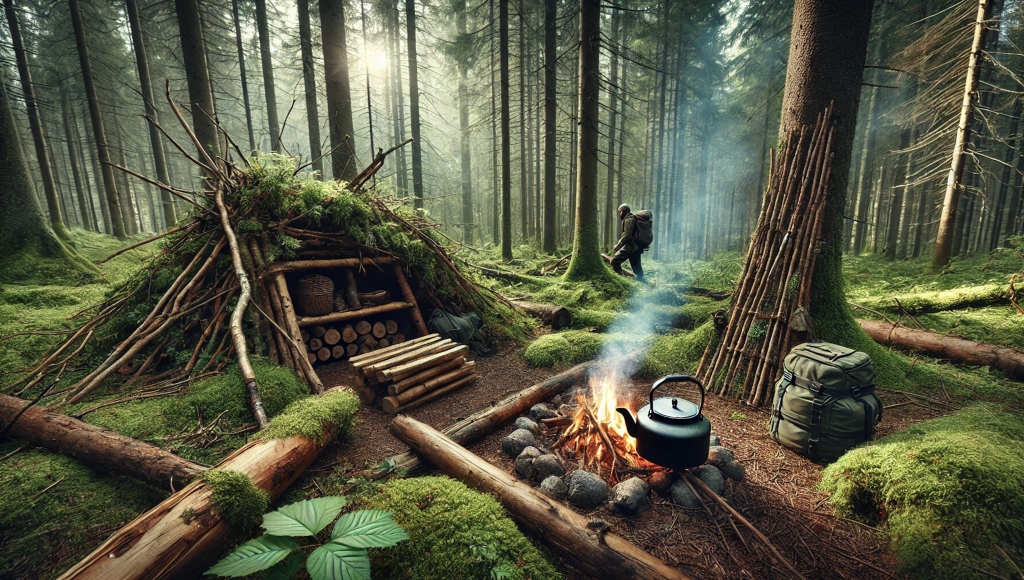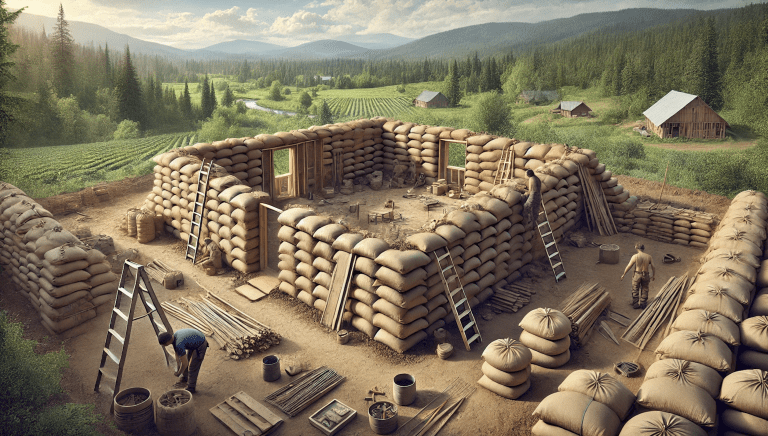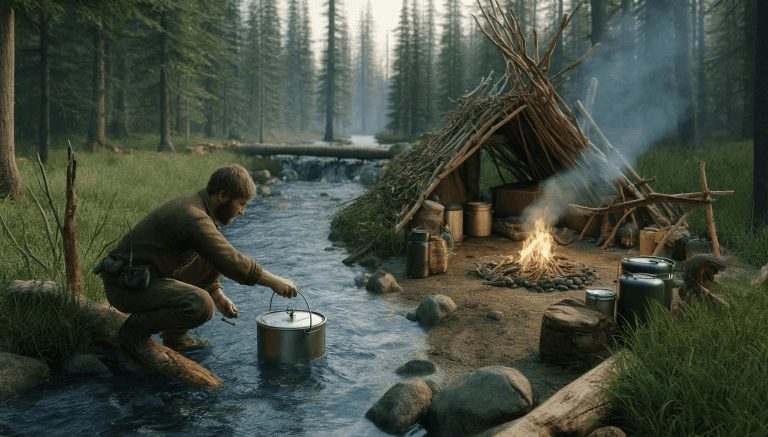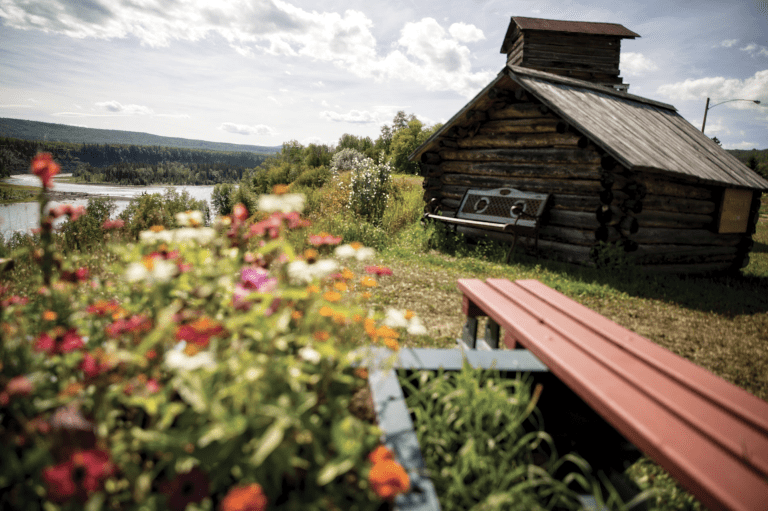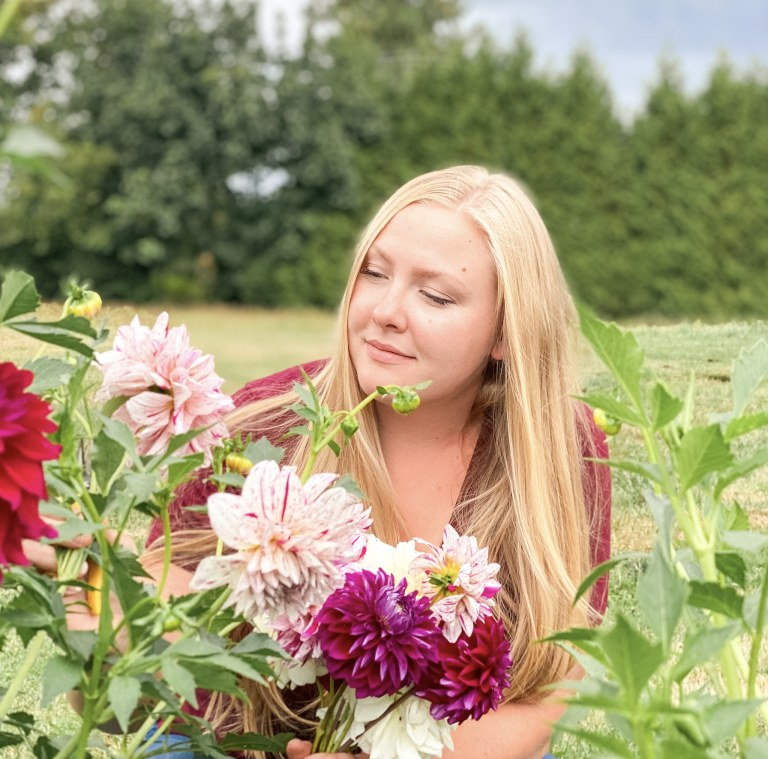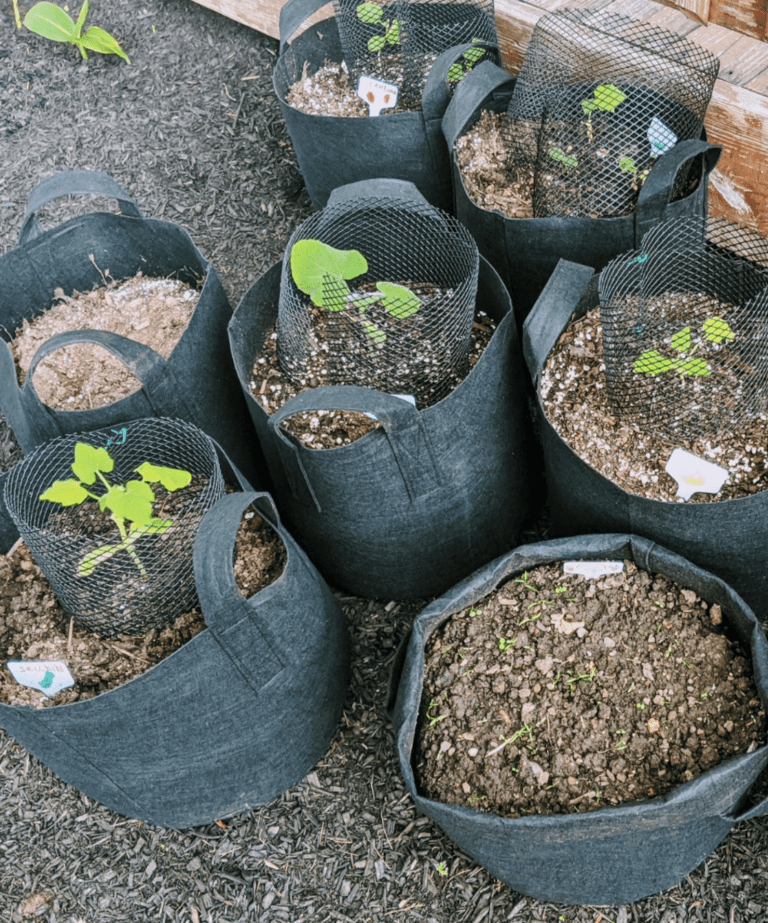Bushcraft is an art form, a way of life, and a means of survival in the wilderness. It’s about using natural resources to meet your needs, from finding food and water to creating shelter and tools. At Wild Bluebell Homestead, we embrace bushcraft as a way to connect deeply with the land, revive ancient skills, and foster a sustainable relationship with nature. In this detailed guide, we’ll explore what bushcraft is, its origins and history, essential terms and skills, the guiding principles of bushcraft, and why we cherish it here at Wild Bluebell Homestead. We’ll also highlight the differences between bushcraft and emergency survival, and invite you to share your bushcraft products with us for review.
What is Bushcraft
Bushcraft is a set of wilderness survival skills that enable individuals to live in the wild with minimal reliance on modern tools and technology. The term combines “bush,” referring to wilderness or uncultivated land, and “craft,” meaning a skill or art form. It is about more than just surviving; it’s about thriving in nature by understanding and utilizing the natural environment to its fullest potential.
Bushcraft involves a variety of practices such as fire-making, shelter-building, foraging, hunting, and tool-making. It’s a holistic approach to wilderness living that fosters a deep connection with the natural world. Unlike emergency survival, which focuses on getting out of a dangerous situation as quickly as possible, bushcraft emphasizes long-term sustainability and harmony with the environment. Practitioners of bushcraft aim to live off the land, using their knowledge and skills to meet their basic needs while leaving as little impact as possible on the surrounding ecosystem.
Origins of Bushcraft
The origins of bushcraft are deeply rooted in the practices of indigenous peoples around the world, who developed the skills necessary to survive in their specific environments. In Canada, the United States, and Europe, these practices were integral to the daily lives of Native American, First Nations, and various European tribes, who relied on their intimate knowledge of the land to find food, build shelter, and create tools.
In Canada, the First Nations people of the boreal forests, such as the Cree and the Dene, were masters of bushcraft. They utilized the abundant natural resources to build shelters, create clothing, and sustain themselves through harsh winters. Similarly, in the United States, tribes like the Apache, Cherokee, and Lakota developed sophisticated bushcraft techniques tailored to the diverse landscapes they inhabited, from deserts to forests.
In Europe, bushcraft has its roots in the practices of ancient tribes such as the Celts and the Norse. These groups lived in close connection with the land, developing skills like fire-making, hunting, and herbal medicine. The term “bushcraft” itself became popular in Australia in the early 20th century, thanks to writers and explorers who documented the survival skills of Aboriginal Australians, but the practices it describes have been part of human history for millennia.
History of Bushcraft
Bushcraft has a rich history that spans the globe and stretches back to the dawn of humanity. In prehistoric times, early humans relied on bushcraft skills for their very survival. They learned to make fire, hunt animals, gather edible plants, and build shelters from natural materials. These skills were passed down through generations, becoming more refined and specialized over time.
In North America, the fur trade in the 17th and 18th centuries brought European trappers and traders into close contact with indigenous peoples, who taught them essential bushcraft skills for surviving the harsh wilderness. Many of these traders, known as “coureurs des bois” in Canada, became highly skilled in bushcraft, adopting the techniques and tools of the Native Americans.
During the 19th and 20th centuries, bushcraft saw a resurgence in popularity, particularly in Europe and North America. Books like Horace Kephart’s “Camping and Woodcraft” (1917) and Mors Kochanski’s “Bushcraft” (1988) played a significant role in reviving interest in these traditional skills. Military organizations also began to incorporate bushcraft training into their programs, recognizing its value for soldiers operating in remote or hostile environments.
Today, bushcraft is enjoying renewed interest as people seek to reconnect with nature and learn the skills necessary to live sustainably. In Canada, the United States, and Europe, bushcraft communities and schools have sprung up, offering workshops and courses that teach everything from fire-making to foraging. This modern bushcraft movement is a testament to the enduring appeal and relevance of these ancient skills.
Key Terms in Bushcraft
Understanding the language of bushcraft is crucial for anyone looking to immerse themselves in this practice. Below is a comprehensive list of key terms related to bushcraft:
- Axe: A fundamental tool in bushcraft, used for chopping wood, splitting logs, and crafting. In regions like Canada and the northern United States, where forests are dense, an axe is indispensable for creating shelters and gathering firewood.
- Batoning: A technique for splitting wood using a knife and a baton—a heavy stick or branch used to strike the knife. Batoning is essential when you need to split wood into smaller pieces for kindling or to create flat surfaces for building.
- Bow Drill: An ancient fire-starting method that uses friction to generate heat and create an ember. The bow drill is a staple of bushcraft, requiring patience and skill. It’s a technique that has been used for thousands of years across different cultures, from the indigenous peoples of North America to early European settlers.
- Bushcraft Knife: A versatile, robust knife designed for various tasks such as carving, cutting, and general utility in the wilderness. The bushcraft knife is often considered the most important tool for a bushcrafter, as it’s used in nearly every aspect of outdoor living.
- Cordage: Rope or string made from natural or synthetic materials. Cordage is used for constructing shelters, setting traps, and securing gear. Making cordage from natural fibers, such as plant stems or animal sinew, is a valuable bushcraft skill.
- Debris Shelter: A type of shelter built from natural materials like leaves, branches, and moss. Debris shelters provide insulation and protection from the elements, making them a critical skill for surviving cold or wet conditions.
- Firesteel (Ferrocerium Rod): A modern fire-starting tool that produces sparks when struck with a metal striker. Firesteel is durable and reliable, making it a favorite among bushcrafters for starting fires in any weather condition.
- Foraging: The practice of searching for and collecting wild food resources, including edible plants, berries, and mushrooms. Foraging is a core bushcraft skill, especially in regions like Canada and Europe, where wild edibles are abundant and varied.
- Hammock Camping: Sleeping in a hammock while in the wilderness, often seen as a comfortable and low-impact alternative to sleeping on the ground. Hammock camping is popular in forested areas where flat ground is scarce.
- Navigation: The art of finding your way in the wilderness, using natural signs, maps, and compasses. Navigation is a critical skill for bushcrafters, ensuring that they can move safely through remote areas.
- Primitive Skills: Techniques and practices developed by ancient peoples, including fire-making, tool crafting, and hunting with primitive weapons. These skills are the foundation of bushcraft and are still practiced today by enthusiasts who seek to live as their ancestors did.
- Sheltercraft: The art of building shelters using natural materials. Sheltercraft is essential in bushcraft, as it provides protection from the elements and is vital for maintaining body heat in cold climates.
- Tracking: The skill of identifying and following animal tracks, used for hunting or wildlife observation. Tracking is a sophisticated bushcraft skill that requires knowledge of animal behavior and the ability to read subtle signs in the environment.
- Wilderness First Aid: Medical techniques adapted for treating injuries and illnesses in remote locations where conventional help may not be available. Wilderness first aid is a crucial skill for bushcrafters, ensuring they can address health issues that arise in the wild.
Core Skills of Bushcraft
Bushcraft is built on a foundation of core skills that are essential for living sustainably in the wilderness. Below is a detailed overview of these skills:
- Firecraft: The ability to create and maintain fire is one of the most fundamental bushcraft skills. Fire provides warmth, light, and a means to cook food and purify water. Traditional methods of firecraft include using a bow drill, hand drill, or flint and steel, while modern bushcrafters might also use firesteel or matches. Mastering firecraft involves understanding different types of tinder, kindling, and wood, as well as how to manage a fire safely in various weather conditions.
- Foraging: Foraging involves identifying and collecting wild edibles, such as plants, berries, nuts, and mushrooms. In bushcraft, foraging is not just about finding food but also understanding the seasons, habitats, and characteristics of different species. In North America and Europe, regions rich in biodiversity, foragers can find an array of edible plants and fungi, from wild garlic and chanterelles to blueberries and acorns. Proper knowledge of foraging ensures that you can supplement your diet with nutritious, natural foods.
- Hunting and Trapping: Hunting and trapping are traditional bushcraft skills used to procure meat and other animal products, such as hides and bones. These skills require knowledge of animal behavior, tracking, and the construction of traps or hunting tools like bows and arrows. Ethical hunting and trapping practices are emphasized in bushcraft, focusing on sustainability and respect for wildlife.
- Navigation: Navigating through wilderness areas is a key skill in bushcraft. This can involve using a compass and map, understanding the natural landscape, and reading the stars. In dense forests of Canada and the United States or the mountainous regions of Europe, proper navigation skills are essential to avoid getting lost. Modern bushcrafters also learn how to use GPS devices, although traditional methods remain the focus.
- Shelter Building: Building a shelter is critical for protection from the elements, whether it’s rain, wind, or cold. Shelter types vary depending on the environment and available materials. In forested regions of Canada and the United States, lean-tos, debris shelters, and snow shelters (like quinzhees) are common. In Europe, structures such as A-frame shelters or dugouts are often used. Effective shelter building requires knowledge of natural materials and construction techniques that provide insulation and stability.
- Tool Crafting: Crafting and maintaining tools is a vital part of bushcraft. This includes making knives, axes, fishing hooks, and other implements from natural materials like wood, stone, and bone. In North America, traditional tool-making skills are influenced by indigenous techniques, such as flintknapping (the process of shaping stone into sharp tools). Properly crafted tools are essential for all other bushcraft activities, from shelter building to food preparation.
- Water Sourcing and Purification: Finding and purifying water is a crucial survival skill. In bushcraft, you learn to locate natural water sources such as rivers, lakes, and springs. Purification methods include boiling, filtering through natural materials, or using modern tools like portable water filters or purification tablets. Understanding how to access clean water is essential for preventing dehydration and waterborne illnesses.
- Wilderness First Aid: Wilderness first aid is adapted to the unique challenges of remote environments. This includes treating injuries such as cuts, burns, sprains, and fractures, as well as managing hypothermia or heat-related illnesses. Knowing how to use natural materials for bandages or splints and having a well-equipped first aid kit are crucial for ensuring safety in the wild.
General Principles of Bushcraft
The practice of bushcraft is guided by several overarching principles that reflect a philosophy of living in harmony with nature. These principles are essential for anyone looking to embrace the bushcraft lifestyle:
- Leave No Trace: This principle emphasizes minimizing your impact on the environment. Bushcrafters aim to leave their surroundings as they found them, avoiding pollution, overharvesting, and unnecessary destruction of natural habitats. Practicing Leave No Trace ensures that natural areas remain pristine for future generations.
- Respect for Nature: A deep respect for nature underpins all bushcraft practices. This respect manifests in the careful and considerate use of natural resources, the protection of wildlife, and the preservation of natural landscapes. Bushcrafters see themselves as part of the natural world, not separate from it, and strive to live in balance with their surroundings.
- Self-Reliance: Self-reliance is at the heart of bushcraft. It involves developing the skills and confidence to survive and thrive independently in the wilderness. Bushcrafters learn to solve problems, adapt to changing conditions, and rely on their knowledge and abilities rather than modern conveniences.
- Sustainability: Sustainability in bushcraft involves using natural resources responsibly and in moderation. Whether it’s gathering food, collecting firewood, or crafting tools, bushcrafters are mindful of the need to preserve ecosystems. This principle is especially important in areas with fragile environments, such as boreal forests or alpine regions.
- Adaptability: The natural environment is unpredictable, and conditions can change rapidly. Bushcrafters must be adaptable, able to modify their plans and techniques to suit the situation. This might mean building a different type of shelter, finding alternative food sources, or navigating around obstacles. Flexibility and resourcefulness are key to success in bushcraft.
Why We Love Bushcraft at Wild Bluebell Homestead
At Wild Bluebell Homestead, bushcraft is more than just a set of skills—it’s a way of life that allows us to reconnect with the land and live in harmony with nature. We love bushcraft because it challenges us to learn, grow, and develop a deeper understanding of the natural world. It’s a practice that brings peace, fulfillment, and a sense of accomplishment as we master the art of living sustainably.
Bushcraft also offers a unique opportunity to preserve ancient knowledge and skills that are at risk of being lost in our modern, technology-driven world. By practicing bushcraft, we honor the wisdom of our ancestors and the indigenous peoples who lived in harmony with the land for thousands of years. Whether it’s building a shelter, starting a fire, or foraging for wild edibles, bushcraft connects us to the earth and reminds us of our place within the natural order.
Bushcraft vs. Emergency Survival
While bushcraft and emergency survival share some common ground, they are fundamentally different in their approach and objectives. Emergency survival is focused on short-term survival in a crisis situation, where the goal is to stay alive and be rescued as quickly as possible. It often involves improvising with limited resources and relying on modern survival tools and techniques.
In contrast, bushcraft is about thriving in the wilderness over a longer period. It emphasizes a deeper connection to nature, with a focus on sustainability, self-reliance, and traditional skills. Bushcrafters seek to live comfortably and harmoniously in the wild, using their knowledge of the environment and natural resources to meet their needs. While both practices require resilience and adaptability, bushcraft is more about living with nature, whereas emergency survival is about overcoming nature.
Send Us Your Bushcraft Products for Review
Do you create high-quality bushcraft gear, equipment, or tools? We’d love to hear from you! At Wild Bluebell Homestead, we are passionate about testing and reviewing the best bushcraft products available. Whether you specialize in handcrafted knives, innovative shelters, or unique outdoor gear, we want to showcase your products to our audience of bushcraft enthusiasts. Send us your items, and we’ll provide an honest, thorough product review that highlights their strengths and potential areas for improvement. Let’s work together to bring the best bushcraft gear to the homesteading community!
Closing Thoughts About Bushcraft
Bushcraft is more than just a collection of survival skills; it’s a journey into the heart of nature and a way to live sustainably and harmoniously with the world around us. By learning and practicing bushcraft, we can reconnect with the land, preserve ancient traditions, and develop the self-reliance needed to thrive in the wilderness.
At Wild Bluebell Homestead, we are committed to sharing our love of bushcraft with others and helping you discover the joys of living simply and sustainably. Whether you’re just starting your bushcraft journey or you’re a seasoned practitioner, we hope this guide has provided you with valuable insights and inspiration.
Thank you for reading the Wild Bluebell Homestead blog. We look forward to continuing this journey with you, exploring the wonders of bushcraft, and sharing our knowledge and experiences. Stay tuned for more tips, guides, and product reviews, and join us in celebrating the art of bushcraft!
additional reading:
Bushcraft USA Forum
Outdoor Life Website
Bushcraft School
BBC News Article
Bushcraft Northwest
Gear Junkie Website
Rewilding Bushcraft
Bushcraft UK Forum
Hunting BC Forum
Much Better Adventures
Premier Body Armor
Beaver Craft Tools
Bushcraft Buddy
Quora Forum

